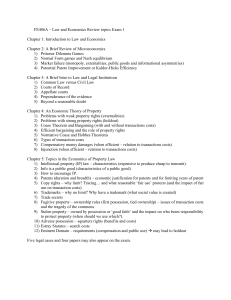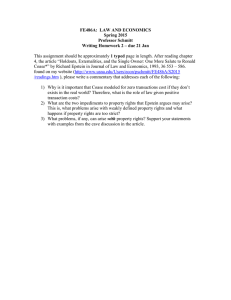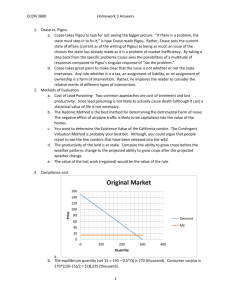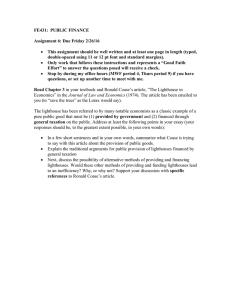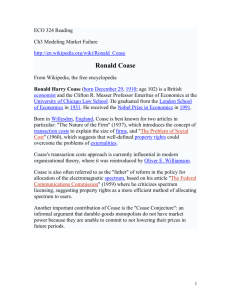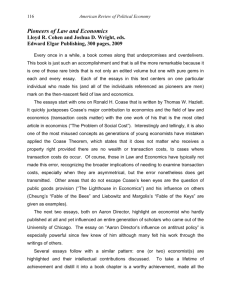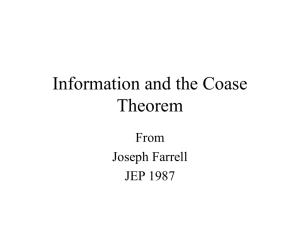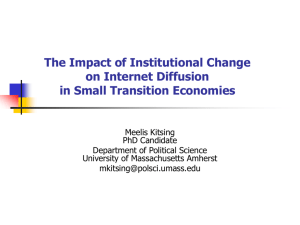The Problem of Social Cost What Problem? :
advertisement
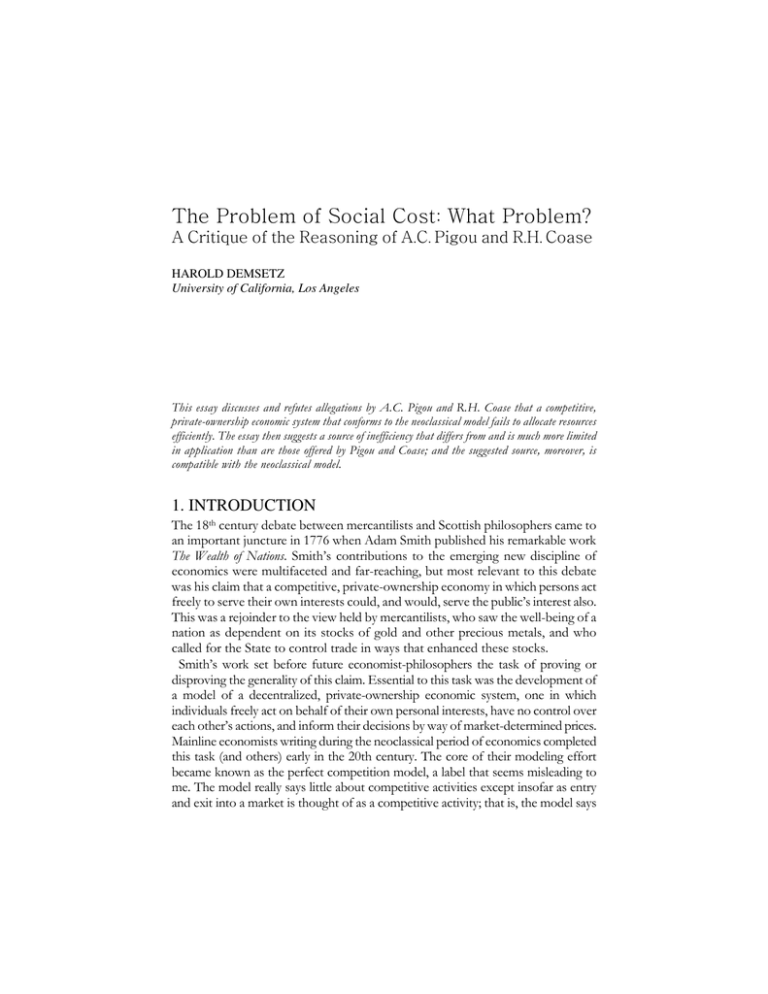
The Problem of Social Cost: What Problem? A Critique of the Reasoning of A.C. Pigou and R.H. Coase HAROLD DEMSETZ University of California, Los Angeles This essay discusses and refutes allegations by A.C. Pigou and R.H. Coase that a competitive, private-ownership economic system that conforms to the neoclassical model fails to allocate resources efficiently. The essay then suggests a source of inefficiency that differs from and is much more limited in application than are those offered by Pigou and Coase; and the suggested source, moreover, is compatible with the neoclassical model. 1. INTRODUCTION The 18th century debate between mercantilists and Scottish philosophers came to an important juncture in 1776 when Adam Smith published his remarkable work The Wealth of Nations. Smith’s contributions to the emerging new discipline of economics were multifaceted and far-reaching, but most relevant to this debate was his claim that a competitive, private-ownership economy in which persons act freely to serve their own interests could, and would, serve the public’s interest also. This was a rejoinder to the view held by mercantilists, who saw the well-being of a nation as dependent on its stocks of gold and other precious metals, and who called for the State to control trade in ways that enhanced these stocks. Smith’s work set before future economist-philosophers the task of proving or disproving the generality of this claim. Essential to this task was the development of a model of a decentralized, private-ownership economic system, one in which individuals freely act on behalf of their own personal interests, have no control over each other’s actions, and inform their decisions by way of market-determined prices. Mainline economists writing during the neoclassical period of economics completed this task (and others) early in the 20th century. The core of their modeling effort became known as the perfect competition model, a label that seems misleading to me. The model really says little about competitive activities except insofar as entry and exit into a market is thought of as a competitive activity; that is, the model says 2 / REVIEW OF LAW AND ECONOMICS 7:1, 2011 nothing about altering price, improving technology, investing in advertising and so on. Its real contribution is to offer an analytically coherent view of the workings of a highly decentralized, unplanned economic system, and it should have been labeled, and in this essay is labeled, ‘perfect decentralization.’ The model sets forth minimal conditions that, if met, were thought by mainstream economists to sustain Smith’s belief that pursuit of private interests serves public interests. Most of these conditions are well known. They include extreme decentralization of resource ownership, full information of prices and of one’s personal preferences, knowledge of available (but fixed in nature) production technologies, and rational personal behavior in pursuit of self-interest. Not explicitly specified, but nonetheless clearly implicit, are presumptions that all scarce resources are privately owned and that private ownership is both understood and respected. The conclusion drawn (rightly or wrongly) from this model was that self-seeking private behavior will result in an efficient allocation of resources. Such an efficient allocation of resources became the implied marker of public interests. The claim of efficiency presumably was stronger for real economic systems that came closer to meeting the assumptions that defined the model.1 Serious monopoly problems or serious disrespect of legal ownership, for example, would cast doubt on a claim that an economy allocates resources efficiently. Later work by Schumpeter and others raised objections to the perfect decentralization model because of its neglect of innovative activities. Two sorts of objections might be raised to perfect decentralization’s claim of efficient resource allocation. One is to find logical error in deductions made from the model, and the other is to declare the model inadequate to deal with the problem whose resolution is its goal. The first type of error is unlikely. The task was to find a set of conditions that, if met, implied efficient resource allocation. The production of these conditions was one of the achievements of the neoclassical effort, and it is doubtful that the conditions that were set in place are insufficient, or even overly-sufficient, to deduce an efficient allocation of resources. The second type of objection offers more fertile ground for debate about this deduction. Objections of the second type can be of two sorts, one of which comes as no surprise. These are claims that the economy is rife with problems of monopoly, scale economies, decision errors and so on. They dismiss the assumptions of the perfect decentralization model for reasons of unrealism. Whether the model is or is not sufficiently realistic may be examined and debated, but not here. The more interesting sort of claim is that the model omits conditions 1 These sufficient conditions, however, are not also claimed to be necessary. An economy planned centrally or one whose processes are more dynamic than those embodied in the perfect decentralization model, such as would be an economy dominated by Schumpeterian ‘creative destruction,’ does not satisfy these conditions but, nonetheless, may allocate resources efficiently. Review of Law & Economics, © 2011 by bepress The Problem of Social Cost: What Problem? / 3 that should be present in a decentralized, private-ownership economic system. That is, the minimal set of conditions set in place by neoclassical economists may be sufficient to deduce an efficient allocation of resources, but they are not sufficient to describe a decentralized, private-ownership economy. R.H. Coase, in his important 1960 article ‘The Problem of Social Cost,’ makes this claim. It is that no decentralized economic system functions without price guidance and exchange. These require resources, but the neoclassical model treats price guidance and exchange as if they are free. The model, therefore, presents an inadequate description of the very economy it seeks to model. The objections offered by A.C. Pigou in his important work The Economics of Welfare (1920) are not clearly of this sort. Instead, they seem to be based on observation of an economic system that is quite different from what we would think describes that which Smith and the neoclassical economists sought to examine. So, let us now turn to the claims of these two formidable doubters. 2. REJECTIONS OF EFFICIENT RESOURCE ALLOCATION Pigou offers constructed examples in which private costs (or benefits) are not equal to social costs (or benefits). His examples differ circumstantially, but in their essences are very similar. A favorite example involves the allocation of traffic between two roads, both of which connect the same terminal points. One road is subject to considerable congestion because it is narrow; the other road is wide and escapes much of this congestion but, lacking the directness of the narrow road, its users require a longer time to travel between the terminal points. Pigou claims that traffic will be inefficiently distributed to these two roads because drivers who choose the quicker road will have done so without regard to the cost their action will put on other users of this road by way of increasing the degree of congestion they face. Hence, the narrow road is over-used and the broad road is under-used. The claimed difference between private cost to a driver (which does not include the added congestion cost borne by others) and social cost (which does include the added congestion cost) is a marker for inefficient resource allocation. So far, so good. But Pigou fails to show that his example is properly placed in the context of a decentralized, private economy. Can a situation that fits this example also fit the conditions that define a (perfect decentralized) private economy? Pigou’s failing in this respect was noted long ago by Frank H. Knight (1924) in a brilliant article on social cost. He notes that Pigou’s discussion of the two roads treats these roads as if entry is free to all. Presumably, then, they are publicly provided and managed open access roads. As such, the example cannot illustrate the inefficiency of an economic system that rests exclusively on private resource allocation. Knight argues that the use of these roads, had they been privately owned (in a competitive setting), would have been priced by their owners so as to http://www.bepress.com/rle/vol7/iss1/art1 DOI: 10.2202/1555-5879.1502 4 / REVIEW OF LAW AND ECONOMICS 7:1, 2011 achieve an efficient allocation of traffic; the price to use the narrow road would have been raised to levels higher than the price asked to use the broad road. Properly interpreted, Pigou’s example reveals the opposite of what he intended. It shows inefficiency arising from a flaw in public or collective management of scarce resources. Public administrators have failed to price the use of these roads so as to achieve an efficient allocation of traffic. I remind the reader that congestion itself is not evidence of inefficiency. Knight’s private roads and Pigou’s recommended tax-subsidy remedy would result in an optimal amount of congestion and not necessarily its complete absence. Pigou’s other examples are of the same sort. They depict conditions that seem quite removed from how we would describe a decentralized, private-ownership economic system (populated by rational persons). A private person (or the Dept. of Recreation) constructs a park but does not control its use by others; the park is over-crowded as a result. But it must be that the owner of the property takes pleasure from the overcrowding or that he neglects his own interest. In the first case there is no inefficiency, since the pleasure he derives from large crowds must be taken into account; in the second case, this person cannot be a resident of the model being examined by Smith or neoclassical economists. A third type of example involves what we now call an agency problem. An owner of land rents the land to an occupant. Pigou asserts that the occupant will not take proper care of the land because he cannot be monitored closely by the owner of the land. Hence, Pigou calls for legislation to reduce the severity of misuse of property. But there is no reason to suppose the State can monitor the renter more effectively than can the land’s owner. It must be then, if the owner is rational, that the cost of monitoring the tenant’s behavior exceeds the added value that doing so would bring to the owner’s property. Hence, there is no inefficiency. All Pigou’s examples that I have examined suffer from this type of failure: they assume faulty behavior or a non-private organizational arrangement (State ownership or the complete absence of ownership) that is precluded by the neoclassical model. Special attention should be given to the last example discussed above, the land-owner/land-renter example, for the assumed positive cost of monitoring comes very close to costs that Coase would classify as transaction costs or as being necessary to a price system. In response to the inefficiencies that he sees, Pigou turns to the State to levy taxes or confer subsidies that result in equality between private and social cost. His manner of doing this idealizes the State, which somehow knows the facts and is able to employ them at less cost than could private parties. He writes of idealized State-directed solutions to the problems that, as illustrated above, are likely to have been caused by the State itself. A Nirvana State is a dangerous tool, for it diverts attention from the real underlying problem. Why is ownership lacking or why is an owner not tending to his self-interest? In The Economics of Welfare and the doctrine that it spawned, the State is but a magic wand that Pigou waves with no effort to Review of Law & Economics, © 2011 by bepress The Problem of Social Cost: What Problem? / 5 make private and social cost equal – the same State that, through its mismanagement, has caused many of the inequalities between private and social cost that Pigou discusses. Notwithstanding the weaknesses in Pigou’s demonstration, his view commanded attention from economists and succeeded in replacing or becoming an appendage to the neoclassical model. Then, in 1960, came Coase’s ‘The Problem of Social Cost.’ Coase noted, as had Knight, that Pigou’s examples were offered without rationalizing their emergence from or within a private ownership, decentralized, competitive economy. Coase then goes on to modify the conditions that describe the decentralized, private-ownership economic system. Since perfect decentralization assumes that all persons know all prices that are relevant to their decisions, the model implicitly assumes that the cost of acquiring knowledge about various opportunities for employing resources is zero. Coase identifies this implicit assumption as a presumption that the price system is free to all to use, and he argues effectively for rejecting this assumption and replacing it with one that recognizes that resources are needed to create and maintain a price system. (Following contemporary discussion, I henceforth denote the cost of creating and maintaining the price system as the cost of transacting.) I concur with Coase in his claim that the perfect decentralization model treats the price system as if it were free. Where Pigou simply conjures unowned resources and failures of contracts, Coase essentially proposes a modified model of a decentralized, private-ownership economic system in which positive transaction cost is embedded. However, had Coase remembered Knight’s work, he might have found an equally good or, in my judgment, a better way to enrich the neoclassical model. The model assumes that private ownership attaches to all resources and that rights of ownership are fully respected. In effect, in addition to a free price system, it assumes a free private ownership system. And we know this cannot be the case. Rather than rely on positive transaction cost, Coase could have insisted on positive cost of ownership, or on both.2 Allow me a moment to defend the way neoclassical economists modeled the economic system. They sought to deduce the consequences of price-informed private decisions. This goal cannot be reached if transaction or ownership costs are positive. Take the extreme case of infinitely high levels of these costs. Infinitely high transaction cost completely blocks exposure to price-guidance; infinitely high privatization cost completely blocks privatization of assets. These costs, then, defeat accomplishment of the desired task – discovering the consequences of 2 Aside from the issues raised in the present essay, I want to recognize Coase’s important demonstration that it makes no more sense to speak of A harming B than of B harming A when A and B seek to put the same scarce resource to competing uses. The history of prior discussion of the externality problem is replete with mistaken attributions of causation when the real source of the problem simply is resource scarcity. http://www.bepress.com/rle/vol7/iss1/art1 DOI: 10.2202/1555-5879.1502 6 / REVIEW OF LAW AND ECONOMICS 7:1, 2011 price-guided privately made decisions. Positive, but less than infinite, transaction and ownership costs allow for some price guidance and private ownership, but this only reduces the degree of inadequacy with which the assumed task is fulfilled. Treating these costs as positive is more realistic but not more useful in coming to an understanding of the functional roles played by prices and ownership in a highly decentralized economic system. However, if the neoclassical goal was not to examine price-informed private decisions but, instead, to describe the essentials of a decentralized, private-ownership economic system, it would seem that positive costs of creating and maintaining a price system and a private ownership system should be acknowledged. After all, the model devised by neoclassical economists assumes that the production of all goods and services requires the use of scarce resources. Interestingly enough, Coase’s emphasis on transaction cost in his social cost article marks a change from the position he took a year earlier in his 1959 article on ‘The Federal Communications Commission.’ Most economists and legal scholars see Coase’s FCC article as the point of departure for his 1960 social cost paper, but in at least one important respect the two papers stand in contrast. The FCC paper is much more in the spirit of Knight’s 1924 article than in that of Coase’s 1960 social cost paper. It was written for a conference whose task was to examine and evaluate the Federal Communications Commission. The dominant rationale used then to justify the existence of the FCC was that the Commission was needed to prevent users of the frequency spectrum from interfering with each other’s broadcast signals. The FCC’s task, and its accomplishment, was to eliminate or reduce the severity of this interference. The Commission achieved this through limits it imposed on the power of broadcast signals, on the proximity in spectrum space of assigned broadcast frequencies, and on the closeness in geographic space of broadcast stations. Coase’s major contribution to the conference undermined this rationale. He argued convincingly that private ownership of the right to broadcast on a specifically defined frequency would suffice to eliminate interference problems or to reduce their severity significantly, doing so by way of legal methods like those used by landowners to prevent trespassing. Coase’s understanding – that private ownership resolves conflicts in the use of a scarce resource – seems to have come as a surprise to many economists, but it was much like Knight’s understanding. In his discussion of the role of ownership, Coase mentions an exception. The resolution of such conflicts through negotiations between private parties might, on occasion, become so complex that something like the FCC might be of help. This exception appears in the FCC paper as just that, an exception. The generally applicable proposition in the article is that market negotiations between broadcasters who are private owners of broadcast rights will effectively resolve interference problems. In Coase’s social cost article, published a year later, this exception becomes the dominating Review of Law & Economics, © 2011 by bepress The Problem of Social Cost: What Problem? / 7 consideration in his criticisms of Pigou and neoclassical economics; complexity of negotiations as discussed in the FCC paper easily becomes cost of using the price system in the social cost paper.3 Using this notion of transaction cost, Coase demonstrates brilliantly that externality-type inefficiencies cannot exist in a world such as is described by the neoclassical model of perfect decentralization, one in which markets and price information are freely accessed and used. Coase then goes on to declare that a world without transaction cost is irrelevant. When turning to the more realistic world in which transaction costs are positive, Coase deceives himself into arguing that the decentralized economic system, after all, may not equate private and social cost. After having pointed to Pigou’s failure to provide a link between an inequality between these costs and the perfect decentralization model, Coase provides a link (or so he thought) in the form of an amendment to the model – simply add transaction cost to the neoclassical model. And, here, more caution than Coase exercised is needed. We know that, if transaction cost is assumed to be zero, the perfect decentralization model yields an efficient allocation of resources, but the model embraces positive costs of producing all other types of goods and services. If these costs do not block the deduction of efficiency, why should the deduction be blocked by including one more type of service – the provision of a price system? Imagine a railroad capable of shipping goods between two firms. The railroad incurs cost if it does this, and the cost may be so high that the shipment does not occur (and, instead, as Coase wrote in ‘The Nature of the Firm’ (1937 ), the would-be receiving firm chooses to rely on in-house production of the good that would have been shipped were there no transport cost). No inefficiency has been created if the shipment does not take place under these circumstances, for the implied gain from making the shipment is less than the cost of doing so. But, pray tell, we reach the same conclusion if we change ‘shipment cost’ to transaction cost. So, we had better re-examine Coase’s reasoning about positive transaction cost. He begins this demonstration with an element of ambiguity about ownership.4 Two parties contend for control of a resource that, apparently, is not yet owned (contrary to the assumption of the perfect decentralization model). They take their dispute to a common-law court. The court identifies one claimant as the legal owner, but it does not prescribe the use to which the chosen person may put the 3 If we are to understand Coase’s argument in his social cost article, it is useful first to understand what he means by the cost of using the price system. He describes what he intends as follows: In order to carry out a market transaction it is necessary to discover who it is that one wishes to deal with, to inform people that one wishes to deal with action needed to make sure that the terms of the contract are being observed, and so on. (Coase, 1960:15). 4 Ironically, Coase’s demonstration has circled round and come back to the source of Pigou’s difficulty – the presumption of the existence of an as yet unowned resource. http://www.bepress.com/rle/vol7/iss1/art1 DOI: 10.2202/1555-5879.1502 8 / REVIEW OF LAW AND ECONOMICS 7:1, 2011 resource; this person might, if he or she chooses, sell control of the resource to someone else. It might well be that there are differences between the two contenders in their capabilities for using the contested resource productively. Assume the court awards the right of ownership to the party whose capability to generate wealth from the use of the resource is the more limited. Realization of the higher value use would nonetheless obtain if the two parties can negotiate after the court has made its decision, since the losing party, by assumption of superior capability, can and will pay more to purchase the resource from the selected party than this party can obtain by directly employing the resource. No inefficiency here. However, the cost of transacting might be so high as to block the negotiation; in this case it appears, as it did to Coase, that the economic system has failed to put the resource to its highest value use. Should this situation be realized, Coase claims that the economic system fails to allocate resources efficiently. However, the appearance of inefficiency is but an illusion. Coase has treated the legal system and its courts as if they are parts of the economic system, when they are not. The situation pictured by Coase is no different from a government levying taxes and offering subsidies in order to achieve a redistribution of wealth. We do not consider the government as a part of the economic system that was of interest to Smith and the neoclassical economists. Since a court’s assignment of a right of ownership of a scarce asset to person ‘A’ creates a different distribution of wealth than would have come about had the court assigned the right to person ‘B,’ the courtroom drama differs hardly at all from a government’s choice of wealth distribution. We would not accuse the market of inefficiency if the government assigned a right to parties that put it to less valuable uses than would others. Why accuse the market of inefficiency if the court does the same? Moreover, enriching the perfect decentralization model with positive transaction cost is quite different from treating the court system as part of the economic system.5 Should the reader favor realism, please note that real social systems in fact design their courts so as to insulate them from the influence of the marketplace. Offers and acceptances of payments to the court for desired decisions are illegal, and a court’s survival is not made to depend on profit earned from the decisions it renders. The neoclassical model of an economy and the conclusions drawn from it are confined to economic institutions, to firms, buyers, sellers, markets and so on. It deduces no conclusions about the resource allocation that results from actions taken by non-market institutions such as courts and legislatures. The implication Coase draws from this case is that the economic system, functioning in the presence of positive transaction cost, can inefficiently allocate 5 The neoclassical model, we may note, assumes that all resources are privately owned and that ownership is fully respected; there is no place in its deductions for the courtroom drama imagined by Coase. Review of Law & Economics, © 2011 by bepress The Problem of Social Cost: What Problem? / 9 resources, but this cannot be deduced from the case he has imagined. The court may have made its choice of owner for reasons different from maximization of market value, since it serves broad social principles, or it simply may have made a mistake because it is not guided in its decisions by a market-based calculus. The proper role of courts in a society is a complex issue, one I do not propose to discuss here. Suffice to note that courts as presently constituted do not function as part of the economic system and do not (explicitly) behave as if they were owners of the resource whose control is being resolved. They are therefore irrelevant to an evaluation of the efficiency of the market-based economic system. The proper domicile of the efficiency calculus, as this was discussed by Pigou and the economics profession (before recent innovations in political economics), is wholly within the economic system. Although there may be very good reasons for not creating a market-like legal system, we may note that if we suppose that courts are remade into market institutions whose survival depends on revenues secured from petitioners who purchase their services and decisions, ownership of a disputed resource would never go to the petitioner who is less capable of maximizing value from its use. Coase’s imagined court decision would never have been made. As courts are presently constituted, the economic system simply takes court decisions (which, in a small way, affect the distribution of wealth) as exogenously imposed constraints on what can and cannot be done, just as the economic system accepts decisions by the State to use taxes and subsidies to redistribute wealth. An efficient economic system is one that makes the most of scarce resources within whatever constraints are handed down to it by courts and legislatures. This means that efficiency is served if the market blocks post-court negotiations between the two claimants discussed, simply because the cost of negotiations between them is expected to exceed the increase in the value derived from realigning ownership of the contested resource. Transaction cost does prohibit owners of resources from knowing all values that might be realized from various uses of their resources, especially for uses imagined by others. The cost of transacting may prevent some of these opportunities from being brought to a resource owner’s attention by way of negotiated offers. However, those values that are not known will be only those for which the cost of acquiring price information is expected to exceed the value of the knowledge that is expected to be obtained from this information. All other prices are known because they are worth knowing. Put differently, there exists an efficient amount of ignorance in an economic system if the cost of acquiring information is positive. The amount of ignorance that is efficient increases as does the cost of transacting (viewed as the cost of conveying information). Ignorance not only may be bliss, it also may be efficient. One cannot claim that resources are wrongly allocated simply because information is not possessed or negotiation is absent; nor can one claim that resources are misplaced because a specific market does not exist. None of http://www.bepress.com/rle/vol7/iss1/art1 DOI: 10.2202/1555-5879.1502 10 / REVIEW OF LAW AND ECONOMICS 7:1, 2011 these is free, and the costs of acquiring information and creating and maintaining markets may be so high as to make it efficient to forego some information and some markets. A decision that something is not worth taking into account is not, because of this, a source of inefficiency. That this something is not taken into account is a reckoning if it follows from a thoughtful anticipation that it is not worth taking into account. An explicit accounting for every ‘something’ would be inefficient indeed in a world in which knowledge is not free.6 There is no difference between transaction cost and other costs in this respect. The amount of soot from the production of steel may remain positive even if its presence results in an increase in the cost of laundering to a nearby laundry owner. If it remains positive because the cost of transacting between laundry and mill owners is too great to make a transaction worth undertaking or because the launderer and steel mill owner believe that the cost of substituting hard coal for soft is too great to make a transaction worth undertaking, then this positive amount of soot is efficient. In both cases, more soot descends on the laundry than if the cost of reducing soot were smaller, but if we do not think resources are wrongly allocated in the case in which hard coal is too costly to use, why should we think resources are wrongly allocated in the case in which transaction cost is too great to bear? Both situations are compatible with efficient resource allocation, and, after all, it is efficiency that is claimed by the neoclassical model, not the complete absence of interaction costs; neither negotiation nor hard coal is sought in and of itself. Indeed, one can rewrite the neoclassical model with transaction cost embedded in it and still deduce from it an efficient allocation of resources. Transaction cost just shifts supply curves upward (or demand curves downward, or some combination of both) as would an increase in any cost, and it carries no special implication of inefficiency at equilibrium values of price and output. The above discussion also applies to positive costs of ownership. Private ownership cannot be created and maintained without the bearing of costs to do so, even if the neoclassical model simplifies things by presuming that all resources are effectively privately owned. There exists an efficient degree of ownership that generally is smaller than ‘100 percent.’ While the neoclassical model eases the pathway to understanding of the roles of prices and ownership, it could, with a bit more difficulty, reach the same conclusion about efficiency while incorporating positive costs of ownership and transactions. Ownership, as a result, would be less than perfect, but perfect would be inefficient if the cost of ownership is positive. (However, see the final section of this essay.) I emphasize that none of what is written above denies the possibility of inefficiency in a competitive, private-ownership economy. My message is that this 6 Early statements of the importance of this principle in regard to transaction costs are found in Demsetz (1964, 1969). Review of Law & Economics, © 2011 by bepress The Problem of Social Cost: What Problem? / 11 possibility is not a result of competitively determined positive transaction or ownership cost. Our reliance on a transaction cost rationale has caused us to exaggerate the scope of externality problems in a reasonably described decentralized economic system that puts control of resources into private hands. Yet, there remains a problem. 3. A DIFFERENT VIEW To avoid problems of scale economies, and the ability to influence price that comes with it, the neoclassical model assumes divisible inputs. However, it places no restrictions on the characteristics of goods and services produced with these inputs. Samuelson in his article ‘The Pure Theory of Public Expenditure’ (1954) notes that some goods are not divisible and, once produced, are available at no additional cost. A national defense policy is available to all citizens at a cost that (theoretically) need not be any larger than is required to make it available to only a few citizens. Similarly, a change in air quality or climate is consumed by all, whether or not they have contributed to the costs of producing this change. This puts these goods and services in a somewhat different category than those considered by neoclassical economists when they settled on the set of conditions sufficient to allow the deduction of efficiency from a decentralized, private-ownership economic system. The model of perfect decentralization implicitly assumes that goods and services are divisible to a degree that allows some to consume them without automatically making them available to all. Hence, the price system is able to reflect individual demands for these goods and to extract individual payments for them. Non-excludable goods, such as these might be, create the ability for people to behave strategically. An inability to establish partitioned ownership rights for goods of this nature creates advantages in the collective provision of them. Such provision would be forthcoming without difficulty if all persons would willingly reveal the true values they attach to different levels of improvement in air quality or different degrees of change in climate, but such honesty is not to be expected. Persons who under-reveal personal true value will be able to argue for reducing the amounts they contribute to pay for these changes while still enjoying these improvements as much as do others. Deceit becomes potentially remunerative in a way not possible if dealing with divisible goods. The potential for deceit is not due to positive transaction cost. If everyone who would benefit from improved climate could transact freely (that is, could be gathered at no cost, could speak to each other at no cost, could write and enforce contracts at no cost), the problem of biased demand revelation would still remain. Under-revelation of demand is not, in its essence, a result of cost imposed by some on others (like soot from a steel mill descending on a laundry). It is a result of psychological propensities to secure a larger share of whatever rent is created through collective action. And this possibility would exist even if a single producer http://www.bepress.com/rle/vol7/iss1/art1 DOI: 10.2202/1555-5879.1502 12 / REVIEW OF LAW AND ECONOMICS 7:1, 2011 of climate change were given rights of ownership to what he created, for what would be the value of such rights if no one can be excluded from enjoying climate change once the change is produced? Surely, the strategic game imposes costs of delay and of practicing deception, but the game would be played even if these costs were zero, simply because some persons believe they are more skilled at, or enjoy more, deceiving others. Here we have human behavior that is consistent with a decentralized, private-ownership economic system, since a private owner can offer to produce a climate change and face competition from other potential producers, but, because of the indivisibility of the product, the owner is unlikely to yield a product that meets true underlying demands for it. Supply and demand in the neoclassical model express true intensity of desire for goods. The neoclassical model, by way of its assumptions, faces buyers and sellers with given non-negotiable equilibrium market prices, prices that cannot be influenced by individual bargaining. It is not designed for and does not treat strategic action. The possibility of misrepresenting one’s position does not depend for its existence on positive cost of transacting; it requires only a prospective favorable distribution of gains from cooperative action. Close reading of Pigou and Coase does not reveal concerns about strategic misrepresentation. The distribution of traffic between Pigou’s two roads is inefficient because no price is charged for using them, not because drivers deceive each other. The failure to realize maximum value from available resources in Coase’s courtroom drama is a problem of legal decision, not one of false testimony. The production of divisible goods, it may be assumed, is less costly if done by competing private parties than by central planners, but this assumption seems less plausible for the production of indivisible goods. The State offers legitimate power to coerce people into what it perceives to be a (tax paid) solution to the collective good problem. This power is not found in the decentralized economic system; that it is not is what makes markets so attractive to lovers of freedom. Yet, coercion can be especially useful in cases in which strategic behavior has impaired agreement on production. Just as we find the State’s ability to coerce legitimately helpful in the maintenance of law and order, so we may find it useful in helping to finance production of goods and services that are important to society but are subject to serious strategic bargaining problems. It is possible in some instances to remedy the problem through a proper set of private rights – that is, to substitute a tollway for a freeway in order to reduce the collective ‘bad’ we call congestion. In other instances this sort of solution is too costly. Resort to State coercion appears more appealing when this is the case. When this is the case, we may claim that the decentralized, private-ownership economy allocates resources inefficiently. People will react to this claim differently, depending on the confidence they attach to proper use of coercion by the State and the value they attach to retaining personal freedom of choice. The rationale for declaring inefficiency for a decentralized, Review of Law & Economics, © 2011 by bepress The Problem of Social Cost: What Problem? / 13 private-ownership economic system in the production of indivisible goods is a willingness to accept a higher degree of coercion than can be secured from the economic system itself when faced with the inadequacy of voluntary arrangements. Strategic behavior problems associated with indivisible goods may be the only category of problems calling for State action in the cause of efficient resource allocation. I do not view strategic behavior as an externality problem, but the name of the category of problems in which we place it is not very important. The important point is that the category of problems that we call externality problems now includes a great many that are not strategic in nature. The preceding parts of this essay were meant to convince readers that these other ‘problems’ should not be associated with inefficient allocation of resources. The literature of externality problems, from Pigou to Coase, makes it seem as if they are associated with inefficiencies, but they are not. The strategic behavior problem, however, seems to me to associate properly with claims of inefficiency if State coercion (unavailable to private dealings) is thought to cost less (socially) than is the gain to be realized from applying coercion to resolve indivisible goods problems. References Coase, R.H. 1937. “The Nature of the Firm,” 4(16) Economica 386-405. _______. 1959. “The Federal Communications Commission,” 2 Journal of Law and Economics 1-40. _______. 1960. “The Problem of Social Cost,” 3 Journal of Law and Economics 1-44. Demsetz, H. 2008. From Economic Man to Economic System. Cambridge, MA: Cambridge University Press. _______. 1964. “The Exchange and Enforcement of Property Rights,” 7 Journal of Law and Economics 11-26. _______. 1969. “Information and Efficiency: Another Viewpoint,” 12(1) Journal of Law and Economics 1-22. _______. 1970. “The Private Production of Public Goods,” 13(2) Journal of Law and Economics 293-306. Knight, Frank H. 1924. “Some Fallacies in the Interpretation of Social Cost,” 38 Quarterly Journal of Economics 582-606. Pigou, A.C. 1920. The Economics of Welfare. MacMillan & Co. Ltd. Samuelson, P.A. 1954. “The Pure Theory of Public Expenditure,” 36(4) Review of Economics and Statistics 387-389. http://www.bepress.com/rle/vol7/iss1/art1 DOI: 10.2202/1555-5879.1502
